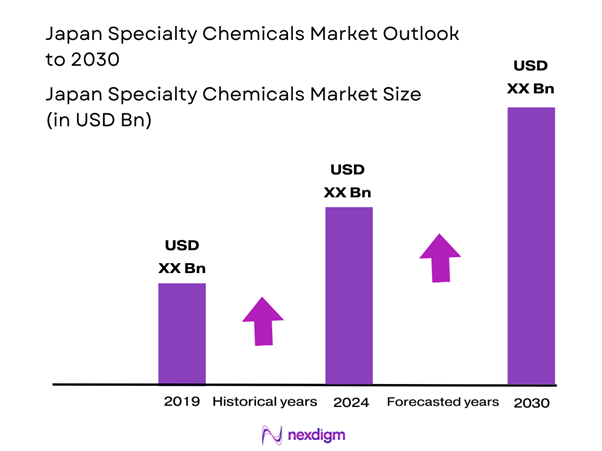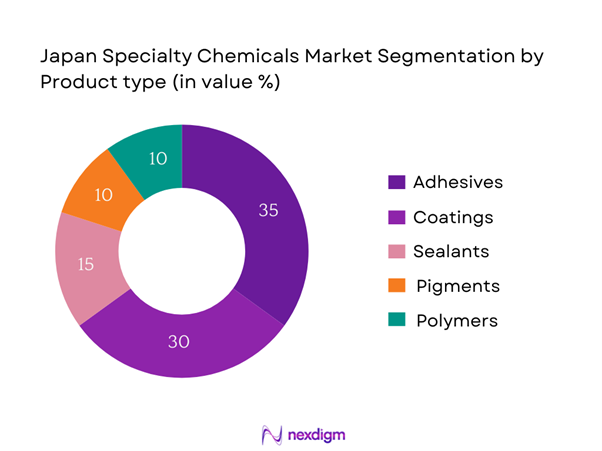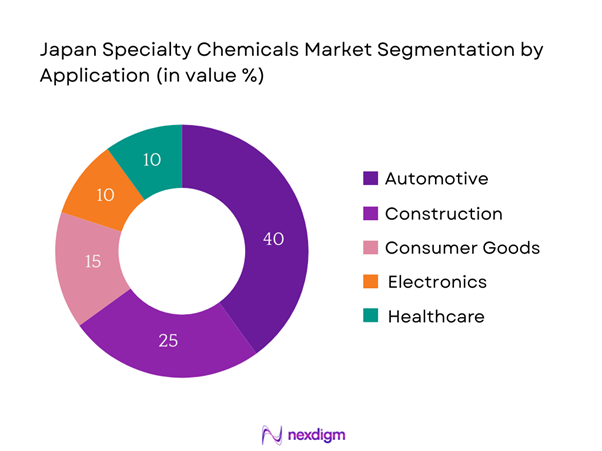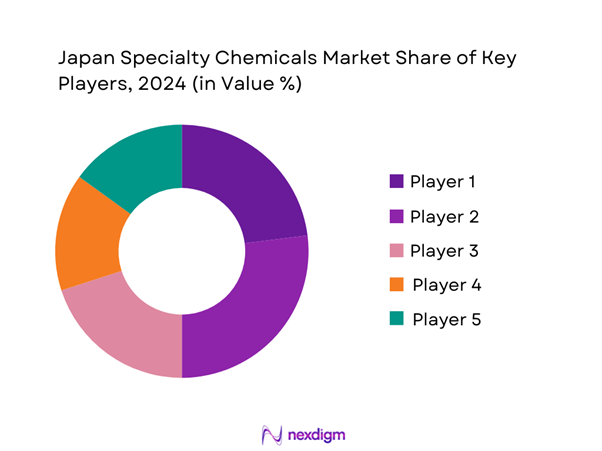Market Overview
The Japan Specialty Chemicals market is valued at USD 38 billion in 2024 with an approximated compound annual growth rate (CAGR) of 6% from 2024-2030, based on a robust historical analysis of industry growth and dynamics. Driving factors include the increasing demand for advanced materials and eco-friendly solutions across various sectors, particularly automotive, electronics, and construction. These sectors are fueled by technological advancements, regulatory support for sustainable practices, and a growing emphasis on high-performance products that cater to specific consumer needs.
The market is significantly influenced by major urban centers such as Tokyo, Yokohama, and Osaka. These cities are economic powerhouses with extensive industrial capabilities, facilitating innovation in specialty chemicals. Their strategic locations, combined with strong R&D infrastructures, contribute to Japan’s dominance in the global specialty chemicals market, making it a hub for both manufacturing and technological development.
The rising demand for eco-friendly products reflects a broader shift in consumer preferences towards sustainability. The Japanese government has targeted reducing greenhouse gas emissions by 46% by 2030. This goal emphasizes the need for eco-efficient specialty chemicals in sectors such as construction, packaging, and automotive. Biodegradable materials, green solvents, and low-VOC (volatile organic compounds) products are increasingly being adopted by manufacturers to align with regulatory requirements and consumer expectations.

Market Segmentation
By Product Type
The Japan Specialty Chemicals market is segmented by product type into adhesives, coatings, sealants, pigments, and polymers. Recently, the adhesives segment has been dominating market share, driven by the increasing applications across various industries such as automotive and construction. This segment is particularly influenced by the rising demand for environmentally friendly adhesives that offer superior bonding capabilities. The growth in construction projects, coupled with advancements in adhesive technology that enhance performance while minimizing environmental impact, underscores the market’s shift towards sustainable solutions.

By Application
The Japan Specialty Chemicals market is further segmented by application into automotive, construction, consumer goods, electronics, and healthcare. The automotive sector leads this market segmentation, owing to the accelerating demand for innovative and lightweight materials that enhance vehicle performance and efficiency. With the push towards electric and autonomous vehicles, specialized chemicals for better insulation, durability, and safety features are in high demand. This trend is bolstered by stringent environmental regulations and consumer expectations for cleaner technology in the automotive sector.

Competitive Landscape
The Japan Specialty Chemicals market is dominated by several key players, including both local and international firms that leverage advanced technology and innovation. The major companies, such as Mitsui Chemicals, Asahi Kasei, and Toray Industries, maintain significant market shares due to their strong R&D capabilities and comprehensive product offerings. This consolidation highlights the competitive landscape defined by substantial investments in innovation and customer-centric approaches.
| Company | Establishment Year | Headquarters | Number of Employees | Revenue (USD Billions) | Market Focus | Key Innovations |
| Mitsui Chemicals | 1912 | Tokyo, Japan | – | – | – | – |
| Asahi Kasei | 1931 | Tokyo, Japan | – | – | – | – |
| Toray Industries | 1926 | Tokyo, Japan | – | – | – | – |
| DIC Corporation | 1908 | Tokyo, Japan | – | – | – | – |
| Shin-Etsu Chemical | 1926 | Tokyo, Japan | – | – | – | – |

Japan Specialty Chemicals Market Analysis
Growth Drivers
Technological Advancements
Technological advancements play a pivotal role in driving the growth of the Japan Specialty Chemicals market. Investment in research and development is projected to reach approximately USD 1.2 trillion by end of 2025, fostering innovation in chemical processing and material science. Enhanced technologies such as artificial intelligence (AI) and the Internet of Things (IoT) are being integrated into manufacturing processes, improving efficiency, safety, and product quality. These technologies enable real-time monitoring and predictive maintenance, thereby reducing downtime and operational costs. Consequently, the enhancements provided through technological innovation significantly bolster the market’s growth potential.
Increasing Urbanization
Japan’s urbanization rate is above 91%, leading to an increased demand for specialty chemicals across diverse sectors, including construction, automotive, and consumer goods. With over 37 million residents, Tokyo remains the most populous metropolitan area globally, necessitating advanced materials for housing and infrastructure developments. This urban growth fuels the need for high-performance products such as adhesives and coatings that meet safety and environmental standards. Furthermore, urbanization drives investments in smart cities and renewable energy, both of which rely heavily on specialty chemicals for sustainable development.
Market Challenges
Regulatory Hurdles
Regulatory hurdles continue to pose significant challenges for the specialty chemicals market in Japan. Compliance with stringent safety and environmental regulations often requires extensive testing and certifications, which can delay product launches. The Chemical Substance Control Law mandates strict assessments of new chemical substances, with over 20,000 substances already registered. Moreover, compliance costs can be upwards of 15% of the total production costs, affecting profitability for manufacturers. Consequently, navigating through these regulations necessitates time and financial investments, creating barriers for innovation and market entry.
Raw Material Price Volatility
Raw material price volatility remains a significant obstacle for the specialty chemicals industry, influenced by global supply chain disruptions and geopolitical tensions. For instance, the price of crude oil, a critical input for many specialty chemicals, fluctuated between USD 70 to USD 130 per barrel from 2022 to 2023, severely impacting manufacturing costs. The rising prices of commodities hampers long-term planning and profitability, as manufacturers struggle with inconsistent pricing models in their production processes. Such volatility can lead to increased operational costs that are ultimately passed down to consumers, impacting market stability.
Market Opportunities
Expanding E-commerce Platforms
E-commerce platforms are rapidly expanding and becoming critical to the distribution of specialty chemicals in Japan, reflecting a shift in buying behavior. E-commerce sales in the B2B sector are projected to reach approximately USD 1 trillion by end of 2025, facilitated by improvements in logistics and digital payment systems. Businesses are increasingly relying on online platforms for procurement, allowing for quicker access to product information and enhanced flexibility in supply chains. This shift towards e-commerce opens new avenues for specialty chemical manufacturers to reach customers directly, expand their market presence, and drive sales growth.
Increasing Focus on R&D
The increasing focus on R&D within the specialty chemicals sector indicates a significant opportunity for growth. Companies are investing heavily in developing innovative products tailored to meet changing consumer preferences and regulatory compliance. Japan’s average R&D spending across industries reached approximately USD 19.2 billion in 2023. Notably, sectors such as pharmaceuticals and biotechnology are driving much of this investment, which aims to develop sustainable and high-performance specialty chemicals. This landscape provides an opportunity for collaborations and partnerships, further enhancing product development and market penetration strategies.
Future Outlook
Over the next five years, the Japan Specialty Chemicals market is expected to experience substantial growth driven by a combination of government support for sustainable practices, increasing investments in R&D, and rising consumer demand for specialty products. The shift towards renewable energy solutions and advanced materials will further enhance growth prospects as industries adapt to new environmental standards and technology advancements. This evolving landscape is likely to foster innovation and strengthen the market’s competitive edge.
Major Players
- Mitsui Chemicals
- Asahi Kasei
- Toray Industries
- DIC Corporation
- Shin-Etsu Chemical
- Sumitomo Chemical
- JSR Corporation
- Showa Denko K.K.
- Santen Pharmaceutical
- Dainippon Ink and Chemicals
- Kuraray Co., Ltd.
- Chugai Pharmaceutical
- Daicel Corporation
- Kinki Chemical
- Ube Industries
Key Target Audience
- Investments and Venture Capitalist Firms
- Government and Regulatory Bodies (Ministry of Economy, Trade and Industry)
- Automotive Manufacturers
- Construction Companies
- Electronics Manufacturers
- Pharmaceutical Corporations
- Distributors and Retailers of Chemical Products
- Industry Associations and Trade Organizations
Research Methodology
Step 1: Identification of Key Variables
The initial phase involves constructing an ecosystem map encompassing all major stakeholders within the Japan Specialty Chemicals market. This step is underpinned by extensive desk research, utilizing a combination of secondary and proprietary databases to gather comprehensive industry-level information. The primary objective is to identify and define the critical variables that influence market dynamics.
Step 2: Market Analysis and Construction
In this phase, we compile and analyze historical data pertaining to the Japan Specialty Chemicals market. This includes assessing market penetration, the ratio of marketplaces to service providers, and the resultant revenue generation. Furthermore, an evaluation of service quality statistics will be conducted to ensure the reliability and accuracy of the revenue estimates.
Step 3: Hypothesis Validation and Expert Consultation
Market hypotheses are developed and subsequently validated through computer-assisted telephone interviews (CATIs) with industry experts representing a diverse array of companies. These consultations provide valuable operational and financial insights directly from industry practitioners, which are instrumental in refining and corroborating the market data.
Step 4: Research Synthesis and Final Output
The final phase involves direct engagement with multiple specialty chemical manufacturers to acquire detailed insights into product segments, sales performance, consumer preferences, and other pertinent factors. This interaction serves to verify and complement the statistics derived from the bottom-up approach, thereby ensuring a comprehensive, accurate, and validated analysis of the Japan Specialty Chemicals market.
- Executive Summary
- Research Methodology
(Market Definitions and Assumptions, Abbreviations, Market Sizing Approach, Consolidated Research Approach, Understanding Market Potential Through In-Depth Industry Interviews, Primary Research Approach, Limitations and Future Conclusions)
- Definition and Scope
- Market Genesis and Evolution
- Timeline of Major Players
- Business Cycle Dynamics
- Supply Chain Analysis
- Value Chain Analysis
- Growth Drivers
Technological Advancements
Increasing Urbanization
Demand for Eco-Friendly Products - Market Challenges
Regulatory Hurdles
Raw Material Price Volatility - Market Opportunities
Expanding E-commerce Platforms
Increasing Focus on R&D - Market Trends
Shift to Biobased Chemicals
Automation in Manufacturing - Government Regulations
Compliance Standards
Environmental Policies - SWOT Analysis
- Stakeholder Ecosystem
- Porter’s Five Forces Analysis
- By Value, 2019-2024
- By Volume, 2019-2024
- By Average Price, 2019-2024
- By Product Type (In Value %)
Adhesives
Coatings
Sealants
Pigments
Polymers - By Application (In Value %)
Automotive
Construction
Consumer Goods
Electronics
Healthcare - By Distribution Channel (In Value %)
Direct Sales
Distributors
Online Sales - By Region (In Value %)
Kanto Region
Kansai Region
Chubu Region
Hokkaido Region - By End-User Industry (In Value %)
Industrial Sector
Agricultural Sector
Pharmaceutical Sector
- Market Share of Major Players (By Value/Volume), 2024
- Cross Comparison Parameters (Company Overview, Business Strategies, Recent Developments, Strengths and Weaknesses, Organizational Structure, Revenues, Revenues by Product Type, Number of Touchpoints, Distribution Channels, R&D Investments, Production Capacity, Unique Value Propositions)
- SWOT Analysis of Key Players
- Pricing Analysis for Major Players
- Detailed Profiles of Major Companies
Mitsui Chemicals, Inc.
Asahi Kasei Corporation
Toray Industries, Inc.
DIC Corporation
Shin-Etsu Chemical Co., Ltd.
Sumitomo Chemical Co., Ltd.
Mitsubishi Chemical Corporation
JSR Corporation
Showa Denko K.K.
Santen Pharmaceutical Co., Ltd.
Dainippon Ink and Chemicals, Inc.
Kuraray Co., Ltd.
Chugai Pharmaceutical Co., Ltd.
Daicel Corporation
Kinki Chemical Co., Ltd.
- Demand and Utilization Patterns
- Purchasing Power Dynamics
- Regulatory and Compliance Requirements
- Customer Needs Analysis
- Decision-Making Process Insights
- By Value, 2025-2030
- By Volume, 2025-2030
- By Average Price, 2025-2030


